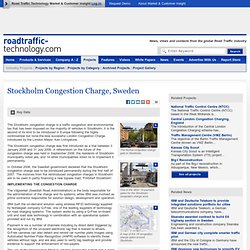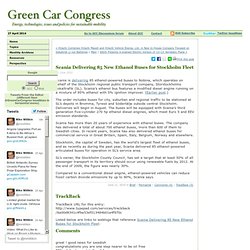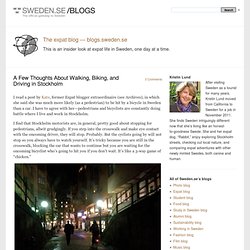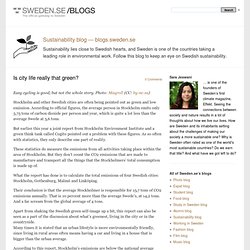

City Overview - Sootfreecities.eu.
Stockholm CityBike Map. Stockholm Congestion Charge - Road Traffic Technology. The Stockholm congestion charge is a traffic congestion and environmental tax that has been imposed on the majority of vehicles in Stockholm; it is the second of its kind to be introduced in Europe following the highly controversial but none-the-less successful London Congestion Charge introduced by the London Mayor, Ken Livingstone.

The Stockholm congestion charge was first introduced as a trial between 3 January 2006 and 31 July 2006. A referendum on the future of the congestion charge was held in September 2006; the residents of Stockholm municipality voted yes, and 14 other municipalities voted no to implement it permanently. In October 2006, the Swedish government declared that the Stockholm congestion charge was to be introduced permanently during the first half of 2007. The%20Stockholm%20Expereience%20final_webb. Scania Delivering 85 New Ethanol Buses for Stockholm Fleet. Scania Delivering 85 New Ethanol Buses for Stockholm Fleet Scania is delivering 85 ethanol-powered buses to Nobina, which operates on behalf of the Stockholm regional public transport company, Storstockholms Lokaltrafik (SL).

Scania’s ethanol bus features a modified diesel engine running on a mixture of 95% ethanol with 5% ignition improver. (Earlier post.) The order includes buses for city, suburban and regional traffic to be stationed at SL’s depots in Bromma, Tyresö and Södertälje outside central Stockholm. Deliveries will begin in August. Scania has more than 20 years of experience with ethanol buses. Stockholm, the capital of Sweden, has the world’s largest fleet of ethanol buses, and as recently as during the past year, Scania delivered 85 ethanol-powered articulated buses for operation in SL’s service area.
SL’s owner, the Stockholm County Council, has set a target that at least 50% of all passenger transport in its territory should occur using renewable fuels by 2012. A Few Thoughts About Walking, Biking, and Driving in Stockholm. I read a post by Kate, former Expat blogger extraordinaire (see Archives), in which she said she was much more likely (as a pedestrian) to be hit by a bicycle in Sweden than a car.

I have to agree with her—pedestrians and bicyclists are constantly doing battle where I live and work in Stockholm. I find that Stockholm motorists are, in general, pretty good about stopping for pedestrians, albeit grudgingly. If you step into the crosswalk and make eye contact with the oncoming driver, they will stop. Probably. But the cyclists going by will not stop so you always have to watch yourself. It’s hard to see people’s faces on the dark, winter streets…Photo by K.Lund Swedish law says that both motorists and cyclists must yield to pedestrians, but what are you gonna do?
Stockholm (voirie et piétons) En Suède, environ 200 des 286 municipalités ont décidé d’entreprendre des activités relevant d’un Agenda 21 local.

Stockholm, avec 730 000 habitants (ou 1, 6 millions pour l’agglomération)en fait partie. Centre industriel, commercial et culturel du pays, située au bord d’un golf de la Baltique et du lac Mälar, sur de nombreuses petites îles, la ville présente de grands atouts naturels qu’elle entend protéger et mettre en valeur. La signature d’un Agenda 21 en janvier 1994 a incité à approfondir la réflexion sur les démarches déjà en cours, dans le cadre de plusieurs "programmes pour la protection de l’environnement" réalisés depuis 1976. Capitale européenne de la culture pour 1998, la ville de Stockholm a alors mis l’accent sur les aspects culturels du développement durable. En fait, celui-ci est seulement possible si les citoyens se sentent concernés par les valeurs que cette notion implique. Donner une véritable dimension humaine à la ville Au centre des actions : le citoyen responsable. STOCKHOLM T-Bana. 1) Spårväg City (S7) - Stockholm's first modern tramway, opened in August 2010 after extending the Djurgårdslinjen, which had been operating with historical trams between Norrmalmstorg and Djurgården since 1991.

More about Stockholm trams here! 2) Lidingöbanan (L21) - a single-track light rail line linking the southern part of Lidingö Island to Ropsten station - currently out-of-service for upgrading, will eventually be linked to Spårväg City. 3) Nockebybanan (L12) - the last of the former rapid tram lines, now operated with modern rolling stock together with the Tvärbanan. Cross-platform interchange with Tunnelbana at Alvik. 4) Tvärbanan (L22) - a new kind of semi-circular light rail line (modern tram), which opened in June 2000 from Gullmarsplan to Alvik (9.4 km) In 2002, it was extended towards the east to Hammarby Sjöstad and Sickla Udde on the eastern side of the Sickla canal.
Citybanan. The Stockholm City Line (Citybanan) is a six kilometre commuter train tunnel laid beneath Stockholm City, from Tomteboda in the north to the Stockholm Södra station.

Once the project has been completed in 2017, the commuter trains will have their own track running through the city and thereby free capacity for long-distance and regional rail traffic to benefit today’s over-loaded Stockholm Central. At present all rail traffic shares two tracks south of Stockholm Central.
This results in constant and significant delays and problems for passengers. The introduction of the Stockholm City Line will double present track capacity. Metro Map Stockholm. "Regard Architecture" par Adrien Buchet. Parution prévue en 2010.

Extraits d’article. Ces dernières années, Stockholm s’évertue à préserver son milieu naturel en conjuguant adroitement l’écologie, les nouvelles technologies et le design. Depuis 1972 et la première conférence des Nations Unies sur l’environnement, les efforts des dirigeants suédois visent à sensibiliser les habitants au respect de la nature. Très active, la petite métropole de 800’000 âmes a fait appliquer immédiatement l’Agenda 21 local de Rio.
Stockholm citizen annual emmissions figures. Easy cycling is good, but not the whole story.

Photo: Maqroll (CC: by-nc-sa) Stockholm and other Swedish cities are often being pointed out as green and low emission. According to official figures, the average person in Stockholm emits only 3,75 tons of carbon dioxide per person and year, which is quite a lot less than the average Swede at 5,6 tons. But earlier this year a joint report from Stockholm Environment Institute and a green think tank called Cogito pointed out a problem with these figures.
As so often with statistics, they only describe one part of reality. These statistics do measure the emissions from all activities taking place within the area of Stockholm. What the report has done is to calculate the total emissions of four Swedish cities: Stockholm, Gothenburg, Malmö and Linköping. Their conclusion is that the average Stockholmer is responsible for 15,7 tons of CO2 emissions annually.